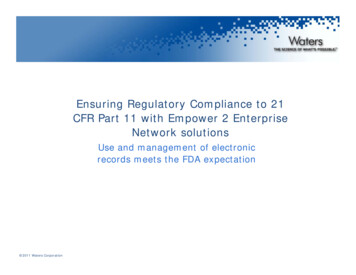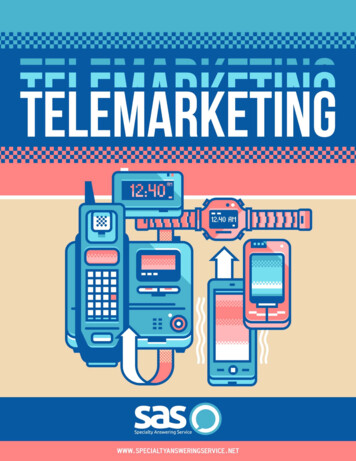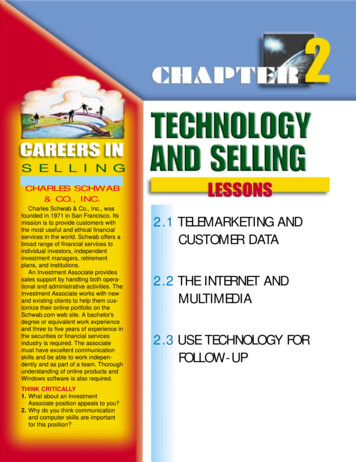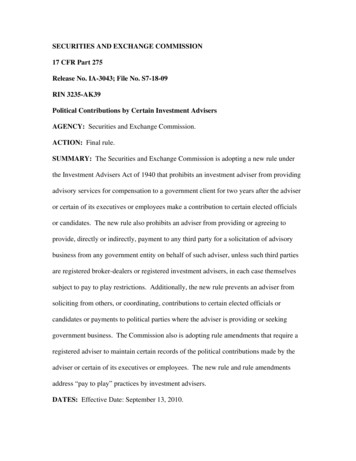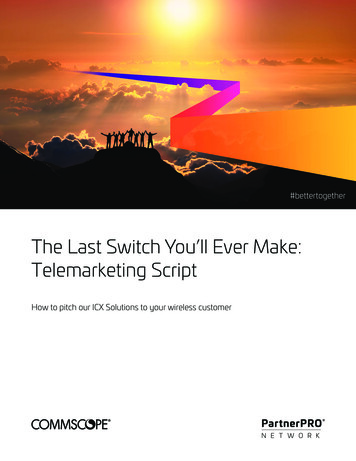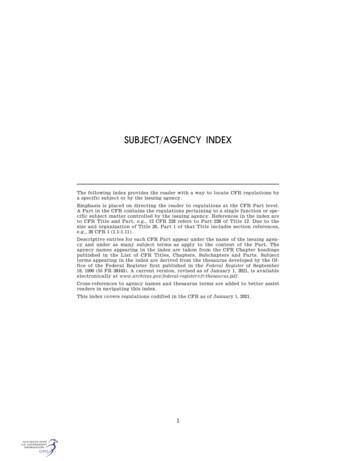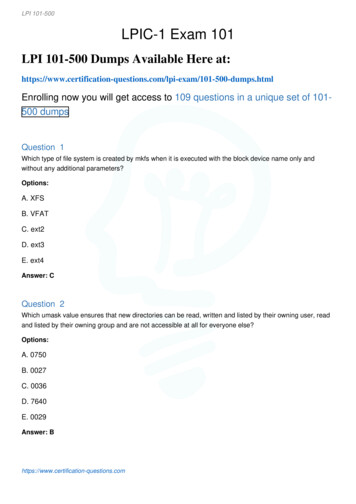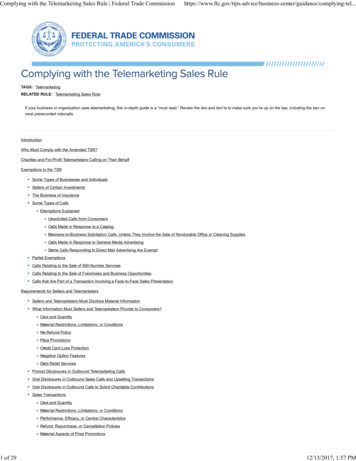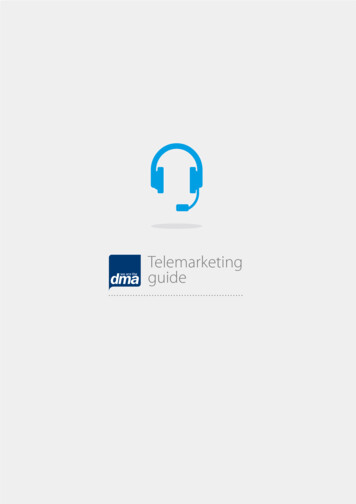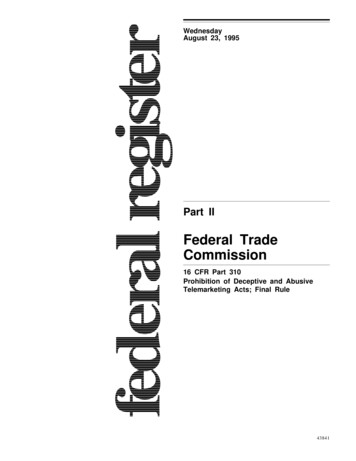
Transcription
federal registerWednesdayAugust 23, 1995Part IIFederal TradeCommission16 CFR Part 310Prohibition of Deceptive and AbusiveTelemarketing Acts; Final Rule43841
43842 Federal Register / Vol. 60, No. 163 / Wednesday, August 23, 1995 / Rules and Regulations16 CFR Part 310specified records be kept; and (11)specifies certain acts or practices thatare exempt from the Rule.Telemarketing Sales RuleStatement of Basis and PurposeFEDERAL TRADE COMMISSIONFederal Trade Commission.ACTION: Statement of basis and purposeand final rule.AGENCY:SUMMARY: The Federal TradeCommission (‘‘Commission’’ or ‘‘FTC’’)issues its Statement of Basis andPurpose and Final Rule pursuant to thetelemarketing and Consumer Fraud andAbuse Prevention Act (‘‘TelemarketingAct’’ or the ‘‘Act’’). Section 3 of the Actdirects the FTC to prescribe regulations,within 365 days of enactment of the Act,prohibiting deceptive and abusivetelemarketing acts or practices.EFFECTIVE DATE: The Rule will becomeeffective December 31, 1995.ADDRESSES: Requests for copies of theRule and the Statement of Basis andPurpose should be sent to PublicReference Branch, Room 130, FederalTrade Commission, 6th Street andPennsylvania Avenue, NW.,Washington, DC 20580.FOR FURTHER INFORMATION CONTACT:Division of Marketing Practices: JudithM. Nixon (202) 326–3173, David M.Torok (202) 326–3140, or Carole I.Danielson (202) 326–3115, FederalTrade Commission, Washington, DC20580.SUPPLEMENTARY INFORMATION: The Rule,in connection with any telemarketingtransaction: (1) Requires clear andconspicuous disclosures of specifiedmaterial information, orally or inwriting, before a customer pays forgoods or services offered; (2) prohibitsmisrepresenting, directly or byimplication, specified materialinformation relating to the goods orservices that are the subject of a salesoffer, as well as any other materialaspects of a telemarketing transaction;(3) requires express verifiableauthorization before submitting forpayment a check, draft, or other form ofnegotiable paper drawn on a person’saccount; (4) prohibits false ormisleading statements to inducepayment for goods or services; (5)prohibits any person from assisting andfacilitating certain deceptive or abusivetelemarketing acts or practices; (6)prohibits credit card laundering; (7)prohibits specified abusive acts orpractices; (8) imposes calling timerestrictions; (9) requires specifiedinformation to be disclosed, truthfully,promptly, and in a clear andconspicuous manner, in an outboundtelephone call; (10) requires thatI. IntroductionOn August 16, 1994, the Presidentsigned into law the Telemarketing Act,1which directs the Commission toprescribe regulations, within 365 daysof enactment of the Act, prohibitingdeceptive and abusive telemarketingacts or practices. The first step inmeeting the Congressional directive wasto publish a Notice of ProposedRulemaking (‘‘NPR’’) in the FederalRegister.2 The provisions of the initiallyproposed Rule published in the NPRwere based on the legislative history ofthe Telemarketing Act,3 on theCommission’s enforcement experience,and on information informally obtainedfrom law enforcement and thetelemarketing industry. The NPR gaveinterested persons 45 days to commenton the proposal. The comment periodon the NPR closed on March 31, 1995.In response to the NPR, the Commissionreceived over 350 comments fromindustry, law enforcement, consumerrepresentatives, individual consumers,and businesses.4From April 18 through 20, 1995,Commission staff conducted a publicworkshop conference in Chicago,Illinois, to discuss the issues raised inthe NPR and the comments received inresponse to the NPR. Twentyassociations or individual businesseswere selected to engage in a roundtablediscussion at the conference.5 Theseparticipants were selected based upon(1) their interest in the rulemakingbased on the likely effect the Ruleultimately will have on them or theirmembers, and (2) their ability torepresent others with similar interests.Participants discussed key aspects of theinitially proposed Rule, addressed eachother’s comments and questions, andresponded to questions fromCommission staff. The conference wasopen to the public, and more than 150observers attended. Time was reservedfor oral comments from members of the1 15U.S.C. 6101–08.FR 8313–8333 (February 14, 1995).3 H.R. Rep. No. 20, 103rd Cong., 1st Sess.; S. Rep.No. 80, 103rd Cong., 1st Sess. (hereinafter referredto as ‘‘House Report’’ and ‘‘Senate Report,’’respectively).4 A list of the commenters to both the NPR andthe Revised Notice of Proposed Rulemaking(‘‘RNPRM’’), including the acronyms used toidentify each commenter in this Statement, isattached as an Appendix.5 The selected participants were: AARP, ATA,ATFA, APAC, ANA, DMA, DSA - Nev., DSA, EMA,ISA, ICTA, MPA, Monex, NAAG, NACAA, NAPA,NCL, NRF, PMAA, and USPS.2 60public each day, and 37 persons spokeduring the course of the three-dayconference. The entire proceeding wastranscribed, and the transcript wasplaced on the public record.6On May 3, 1995, in an open meeting,Commission staff briefed all theCommissioners about the rulemakingprocess, the issues raised in the writtencomments and the public workshopconference, and outlined possibleapproaches to address the issuescommenters raised. The briefing wastranscribed, and the transcript wasplaced on the public record.On June 8, 1995, the Commissionpublished in the Federal Register aRevised Notice of Proposed Rulemaking(‘‘RNPRM’’) 7 for additional publiccomment. The revised proposed Rulepublished in the RNPRM reflectedcontinued consideration of the Act’slegislative history, the writtencomments received in response to theNPR, and information learned at theworkshop conference. The publiccomment period on the RNPRM closedon June 30, 1995. The Commissionreceived over 350 comments to theRNPRM from interested parties,including industry, law enforcement,consumer representatives, individualconsumers, and businesses.Individual consumers whocommented favored restrictingtelemarketing; some even urged theCommission to prohibit telemarketingcompletely. Industry and businesscomments were generally positive aboutthe revised proposed Rule. Lawenforcement and consumer groups,however, expressed concern that manyof the provisions in the initiallyproposed Rule, which, they asserted,provided consumers with much neededprotection, had been eliminated fromthe revised proposed Rule.The entire public record to date,including the comments, the publicworkshop conference transcript, and theCommission open meeting transcript isavailable on CD–ROM. In addition, thepublic record up to, but not includingthe RNPRM and the comments receivedin response to the RNPRM, was placedon the Internet.86 References to the conference transcript are citedas ‘‘Tr.’’ followed by the appropriate pagedesignation. References to comments are cited as‘‘[acronym of commenter] at [page number].’’Unless otherwise indicated, all comment referencesin this Statement are to the comments received inresponse to the RNPRM.7 60 FR 30406–30428 (June 8, 1995).8 The FTC gopher server address isCONSUMER.FTC.GOV 2416. For World Wide Webaccess, the URL is GOPHER://CONSUMER.FTC.GOV:2416.
Federal Register / Vol. 60, No. 163 / Wednesday, August 23, 1995 / Rules and Regulations 43843II. Discussion of the RuleA. Section 310.1: Scope of theRegulationsSection 310.1 of the Final Rule statesthat this part implements theTelemarketing Act.The Commission received a numberof comments on the initially proposedRule asking that the Commissionexpressly exempt those entities that arenot subject to the Federal TradeCommission Act (‘‘FTC Act’’), 15 U.S.C.41 et seq.9 In response to thosecomments, the revised proposed Ruleadded language to this Section that wasintended to clarify that the Rule doesnot apply to any activity outside thejurisdiction of the FTC Act. In thatregard, the Commission quoted theTelemarketing Act as follows:[N]o activity which is outside thejurisdiction of (the FTC) Act shall be affectedby this Act.10After reviewing the record in thisrulemaking, the Commission hasdecided to delete the additionallanguage from the Final Rule. TheTelemarketing Act makes clear that theRule does not apply to any activityexcluded from the Commission’sjurisdiction; thus, restating this in theRule is unnecessary. By deleting thislanguage, the Commission does notintend to expand or contract itsjurisdiction or the scope of the Rule’scoverage. The Commission’sjurisdictional limitations are set forth insection 5(a)(2) of the FTC Act; 11accordingly, the Rule does not apply to:banks, savings and loan institutionsdescribed in section 18(f)(3), 12 Federal creditunions described in section 18(f)(4), 13common carriers subject to the Acts toregulate commerce, air carriers and foreignair carriers subject to the Federal AviationAct of 1958, and persons, partnerships, orcorporations insofar as they are subject to thePackers and Stockyards Act, 1921, asamended, except as provided in section406(b) of said Act.14In addition, the Rule does not applyto any entity that is not ‘‘organized tocarry on business for its own profit orthat of its members.’’ 15 Finally, the Rule9 See, e.g., initial comments: GHAA at 3; AT&Tat 6–13; AmEx at 3; ABA at 1; BOB at 1; ASAE at2; SCIC at 7.10 15U.S.C. 6105(a).11 15U.S.C. 45(a)(2).12 Section18(f)(3) of the FTC Act, 15 U.S.C.57(f)(3), describes ‘‘savings associations as definedin section 3 of the Federal Deposit Insurance Act,’’12 U.S.C. 1811 et seq.13 Section 18(f)(4) of the FTC Act, 15 U.S.C.57(f)(4), describes ‘‘Federal credit unions undersections 120 and 206 of the Federal Credit UnionAct (12 U.S.C. 1766 and 1786).’’14 15 U.S.C. 45(a)(2).15 See 15 U.S.C. 44.does not apply to the business ofinsurance to the extent that suchbusiness is regulated by State law.16Other commenters 17 requested thatthe Final Rule expressly exclude fromcoverage those investment entitieswhich were expressly excluded underthe Telemarketing Act.18 Again, theTelemarketing Act clearly excludes suchentities and the Rule need not reiteratethe statutory exclusion.The Commission also receivedcomments expressing differing views onwhether parties acting on behalf oforganizations exempt under section 5 ofthe FTC Act should be expressly exemptfrom the Rule. Some commenters urgedthe Commission to exclude agents ofexempt organizations from Rulecoverage.19 The Commission does notsee a need to provide broadly for theexemption of agents in the Rule. TheFTC Act itself establishes exemptionsfrom its coverage, and theTelemarketing Act provides thatauthority under the Rule may be nobroader than under the FTC Act. Thus,for example, banks and airlines wouldnot be subject to the Final Rule, becausethey are exempt under section 5 of theFTC Act.20 Similarly, section 4 of theFTC Act exempts corporations that arenot acting for their profit or that of theirmembers.21 However, a nonbankcompany that contracts with a bank toprovide services on behalf of the bank,and a non-airline company thatcontracts with an airline to provideservices on behalf of the airline, are notexempt from the FTC Act.22 Similarly, acompany that is acting for profit wouldbe subject to the FTC Act even when16 See Section 2 of the McCarran-Ferguson Act, 15U.S.C. 1012(b).17 See, e.g., CUNA at 3–4.18 As noted in the RNPRM, Sections 3 (d) and (e)of the Telemarketing Act, 15 U.S.C. 6102 (d) and(e), exclude from Rule coverage any of the followingpersons: a broker, dealer, transfer agent, municipalsecurities dealer, municipal securities broker,government securities broker, government securitiesdealer (as those terms are defined in Section 3(a)of the Securities and Exchange Act of 1934, 15U.S.C. 78c(a)), an investment adviser (as that termis defined in Section 202(a)(11) of the InvestmentAdvisers Act of 1940, 15 U.S.C. 80b–2(a)(11)), aninvestment company [as that term is defined insection 3(a) of the Investment Company Act of1940, 15 U.S.C. 80a–3(a)), any individual associatedwith those persons, or any persons described insection 6(f)(1) of the Commodity Exchange Act, 7U.S.C. 8, 9, 15, 13b, 9a.19 See, e.g., Chase at 1; AT&T at 5–6; BOA at 1;IBAA at 1; Consortium at 2; ATFA at 3. See, e.g.,initial comments: ABA at 1; Advanta at 1; Chase at2; Citicorp at 3; NFN at 2.20 15 U.S.C. 45(a)(2); FTC v. Miller, 549 F.2d 452(7th Cir. 1977).21 15 U.S.C. 44; Community Blood Bank v. FTC,405 F.2d 1011 (8th Cir. 1969).22 See, e.g., Official Airlines Guides, Inc. v. FTC,630 F.2d 920 (2d Cir. 1980); FTC v. Miller, 549 F.2d452 (7th Cir. 1977).providing services to a nonprofitcorporation. The Commission is notaware of any reason why the Final Ruleshould create a special exemption forsuch companies where the FTC Actdoes not do so. Accordingly, the FinalRule does not include special provisionsregarding exemptions of parties actingon behalf of exempt organizations;where such a company would be subjectto the FTC Act, it would be subject tothe Final Rule as well.B. Section 310.2: DefinitionsThe revised proposed Rule definedthe following terms: ‘‘acquirer,’’‘‘attorney general,’’ ‘‘cardholder,’’‘‘Commission,’’ ‘‘credit,’’ ‘‘credit card,’’‘‘credit card sales draft,’’ ‘‘credit cardsystem,’’ ‘‘customer,’’ ‘‘investmentopportunity,’’ ‘‘material,’’ ‘‘merchant,’’‘‘merchant agreement,’’ ‘‘outboundtelephone call,’’ ‘‘person,’’ ‘‘prize,’’‘‘prize promotion,’’ ‘‘seller,’’ ‘‘state,’’‘‘telemarketer,’’ and ‘‘telemarketing.’’Only the terms ‘‘investmentopportunity,’’ ‘‘material,’’ ‘‘seller,’’ and‘‘telemarketing’’ elicited muchcomment. Additionally, somecommenters called for a definition ofthe term ‘‘clear and conspicuous,’’ asthat term is used in Sections 310.3(a)(1)and 310.4(d) of the revised proposedRule.In the Final Rule, the Commission hasmodified the definitions of ‘‘investmentopportunity’’ and ‘‘seller.’’ All otherdefinitions have been adopted in theFinal Rule without change from therevised proposed Rule. The Commissionalso has determined that the term‘‘telemarketing’’ needs no furthermodification.The Commission considered, butrejects, comments calling for a furtherdefinition of the phrase ‘‘clear andconspicuous.’’ 23 The Commissionbelieves it is unnecessary to define theterm ‘‘clear and conspicuous’’ in theRule because the concept is welldeveloped in Commission case law andpolicy statements.24 Moreover, theCommission believes that mandatingrigid ‘‘clear and conspicuous’’ criteriawould be inconsistent with the goal ofallowing businesses maximumflexibility as long as customers receive23 AARP at 12; CFA at 5–6; NCL at 12–13; USPSat 8.24 See, e.g., Thompson Medical Co., 104 F.T.C.648, 797–98 (1984); The Kroger Co., 98 F.T.C. 639,760 (1981); Statement of Enforcement Policy, ‘‘Clearand Conspicuous Disclosures in TelevisionAdvertising,’’ Trade Regulation Reporter (CCH) ¶7569.09 (Oct. 21, 1970); Statement of EnforcementPolicy, ‘‘Requirements Concerning Clear andConspicuous Disclosures in Foreign LanguageAdvertising and Sales Materials,’’ 16 CFR 14.9.
43844 Federal Register / Vol. 60, No. 163 / Wednesday, August 23, 1995 / Rules and Regulationsthe material information they need tomake purchasing decisions.1. Section 310.2(u): Definition of‘‘Telemarketing’’The definition of ‘‘telemarketing’’ setsthe parameters of the Final Rule. Thedefinition in the Final Rule reflects thestatutory definition set forth byCongress in section 7(4) of theTelemarketing Act.25Some commenters requested that theCommission exempt calls made byconsumers in response to writtenadvertisements and promotionalmaterials sent by financial institutionsor their agents that comply with thedisclosure requirements in the Truth inLending Act (‘‘TILA’’), 15 U.S.C. 1601 etseq., and its implementing Regulation Z(‘‘Reg. Z’’), 12 CFR part 226.26 TheCommission has determined that such abroad exemption is inappropriate. TheTILA and Reg. Z disclosures for creditand charge card solicitations, 15 U.S.C.1631–1632; 12 CFR 226.5–226.5a, relateto specific costs and terms of credit, butdo not contain many of the otherprotections that would be available toconsumers under §§ 310.3 and 310.4 ofthis Rule. The Commissionacknowledges, however, that certaincredit disclosures required undersections 1631–1632 of the TILA and§§ 226.5–226.5a of Reg. Z are sufficientfor compliance with some of the FinalRule’s affirmative disclosures set forthin § 310.3(a)(1). Therefore, the FinalRule makes clear that compliance withthe TILA and Reg. Z will suffice forpurposes of compliance with§ 310.3(a)(1)(i) of the Rule.The Commission intends that thephrase ‘‘goods or services’’ contained inthe definition of ‘‘telemarketing’’ coverany tangible and intangible goods orservices including, but not limited to,leases, licenses, or memberships. Prizesand awards are also included as ‘‘goodsor services’’ under the definition of‘‘telemarketing.’’ This is consistent withthe legislative history of theTelemarketing Act 27 and reflects theCommission’s enforcement experiencein this area.The Telemarketing Act and the FinalRule exempt from the definition oftelemarketing all solicitations of salesthrough the mailing of a catalog,28 whenthe person making the solicitation does25 15U.S.C. 6106(4).e.g., Chase at 2.27 See House Report at 11; Senate Report at 8.28 The Telemarketing Act and the Final Rulerequire catalogs to include multiple pages of writtendescriptions or illustrations of the goods or servicesbeing offered for sale, to include a business addressof the seller, and to be issued not less frequentlythan once a year.26 See,not call customers but only receivescalls from customers in response to thecatalog and only takes orders duringthose calls, without further solicitation.The Commission has determined thatthe term ‘‘without further solicitation’’requires interpretation. Appliedliterally, the term could bar conduct thatwould not be deceptive or abusive,including asking catalog customers whohave placed orders whether they wish tobuy another item. There is no reason tosuppose that Congress intended such aresult. The Final Rule permits that,when catalog sellers receive calls fromcustomers, the person taking the ordermay provide further information to thecustomer about, or may try to sell, anyother item included in the same catalogwhich prompted the customer’s call, orin a substantially similar catalog,without losing the exemption from thedefinition of ‘‘telemarketing.’’ TheCommission’s experience in the area ofcatalog sales suggests that thisclarification will burden neitherlegitimate catalog sellers nor exposetheir customers to a significant risk ofthe type of deception or abuse that theFinal Rule is intended to address.2. Section 310.2(j): Definition of‘‘Investment Opportunity’’Section 310.2(j) of the Final Ruledefines ‘‘investment opportunity’’ asanything, ‘‘tangible or intangible, that isoffered, offered for sale, sold, or tradedbased wholly or in part onrepresentations, either expressed orimplied, about past, present, or futureincome, profit, or appreciation.’’ TheRNPRM clarified that the definition ofthe term ‘‘investment opportunity’’ didnot include sales of franchises subject tothe Commission’s Franchise Rule, 16CFR part 436. To clarify further that theRule does not cover such franchisesales, the Commission has deleted thatlanguage from the Final Rule’sdefinition of ‘‘investment opportunity’’and has created an express exemptionfor such transactions in § 310.6(b).3. Sections 310.2(r) and (t): Definitionsof ‘‘Seller’’ and ‘‘Telemarketer’’In response to a suggestion from acommenter,29 the Commission hasmodified the definition of ‘‘seller’’ toclarify that the term includes not onlypersons who, in connection with atelemarketing transaction, provide oroffer to provide goods and services tothe customer in exchange forconsideration, but also persons who, inconnection with a telemarketingtransaction, arrange for others toprovide goods or services to the29 NASAAat 1.customer. The Commission made thischange in order to clarify that the Rule’scoverage cannot be avoided bystructuring a sale so that someone otherthan the seller actually provides thegoods or services directly to thecustomer.Another commenter requestedclarification of the definition of ‘‘seller’’with respect to its application todiversified companies or divisionswithin one parent organization.30 TheCommission intends that distinctcorporate divisions may be consideredseparate ‘‘sellers.’’ The determination asto whether distinct divisions of a singlecorporate organization will be treated asseparate sellers will depend on suchfactors as: (1) whether there existssubstantial diversity between theoperational structure of the corporateorganization and the division that isselling the goods or services that are thesubject of the offer, or between thatdivision and the other divisions of thecorporation; or (2) whether the nature ortype of goods or services offered by thedivision are substantially different fromthose offered by other divisions of thecorporation or the corporateorganization as a whole.Section 310.2(t) of the Final Ruledefines ‘‘telemarketer’’ as ‘‘any personwho, in connection with telemarketing,initiates or receives telephone calls to orfrom a customer.’’ The Commissionintends that the term ‘‘telemarketer’’apply to persons making a telephonecall to, or receiving a telephone callfrom, a customer in connection with thepurchase of goods or services.31 It doesnot include persons making or receivingcustomer service calls or similartangential telephone contacts, unless asales offer is made or accepted duringsuch calls.One commenter asserted that sellersand telemarketers should be held jointlyliable under the Rule for the actions ofthe other.32 NYSCPB stated that, absentlegislative history indicating that jointand several liability is contrary to theintent of Congress, the Commissionshould apply joint and severalliability.33 NYSCPB pointed out that inmany instances a telemarketer engagingin fraud may abscond before lawenforcers can move against it. NYSCPBexpressed concern that, in such cases,State law enforcers might not be able tomove against others involved in the30 Rollinsat 1–2.previously stated in discussing thedefinition of ‘‘telemarketing,’’ the Commissionintends that a ‘‘prize,’’ as that term is defined in§ 310.2(p), is a good or service for purposes of thisRule.32 NYSCPB at 3–4.33 Id.31 As
Federal Register / Vol. 60, No. 163 / Wednesday, August 23, 1995 / Rules and Regulations 43845deceptive telemarketing scheme whoremain within their reach.The Commission declines to readjoint and several liability for sellers andtelemarketers into the TelemarketingAct. The assisting and facilitatingprovisions in § 310.3(b) of the Rule moreappropriately provide a basis for anaction by State enforcers in the situationdescribed by NYSCPB.4. Sections 310.2 (a), (c), (e), (f), (g), (h),(l), and (m): Credit-Related DefinitionsThe revised proposed Rule definedvarious credit-related terms that comeinto play primarily in § 310.3(c), whichaddresses credit card laundering. Theseterms are: ‘‘Acquirer,’’ ‘‘cardholder,’’‘‘credit,’’ ‘‘credit card,’’ ‘‘credit cardsales draft,’’ ‘‘credit card system,’’‘‘merchant,’’ and ‘‘merchantagreement.’’ The Commission hasadopted these definitions withoutchange in the Final Rule. No furtherdiscussion is necessary in thisStatement regarding the definitions of‘‘acquirer,’’ ‘‘cardholder,’’ ‘‘merchant,’’and ‘‘merchant agreement.’’Section 310.2(e) defines ‘‘credit’’ tomean ‘‘the right granted by a creditor toa debtor to defer payment of debt or toincur debt and defer its payment.’’ Thisdefinition delineates the scope of§ 310.3(c), which prohibits credit cardlaundering. Several commenters urgedthe Commission to extend the scope of§ 310.3(c) to include other paymentdevices such as debit cards because theybelieve such devices can be launderedas easily as credit card transactions.34Based on the language of theTelemarketing Act 35 and its legislativehistory,36 however, the Commissionbelieves that Congress meant to prohibitcredit card laundering predicated uponthe definition of ‘‘credit’’ usedthroughout the consumer credit statutes,and did not contemplate coverage of allelectronic payment systems. Thereforethe definition of ‘‘credit’’ tracks thestatutory definition of ‘‘credit’’ underthe TILA.37Section 310.3(f) of the Final Ruledefines ‘‘credit card’’ as ‘‘any card,plate, coupon book, or other creditdevice existing for the purpose ofobtaining money, property, labor, orservices on credit.’’ This definition isidentical to the statutory definition of‘‘credit card’’ contained in the TILA.38Again, the Commission has defined‘‘credit card’’ as it is used throughout34 E.g.,Citicorp at 2; VISA at 2–4.U.S.C. 6102(a)(2).36 See generally House Report at 2; Senate Reportat 2, 10.37 15 U.S.C. 1603(e).38 15 U.S.C. 1603(k).35 15the consumer credit statutes forconsistency and to clarify that § 310.3(c)does not include other payment devices.Section 310.2(g) defines the term‘‘credit card sales draft’’ as ‘‘any recordor evidence of a credit cardtransaction.’’ This definition is designedto be flexible enough to anticipate futuretechnological changes in how creditcard transactions are processed andhandled and, therefore, does not refer tospecific forms of records. Thisdefinition is intended to embody thebroadest possible range ofrecordkeeping formats that will comewithin the scope of the Rule.Section 310.2(h) of the Final Ruledefines ‘‘credit card system’’ as ‘‘anymethod or procedure used to processcredit card transactions involving creditcards issued or licensed by the operatorof that system.’’ This definition does notinclude any in-house ‘‘system’’ that aseller or telemarketer may put in place.Rather, the Commission intends thatthis definition include only a credit cardsystem to process credit cardtransactions involving credit cardsissued or licensed by the credit cardsystem operator.5. Section 310.2(k): Definition of‘‘Material’’The Final Rule states that the term‘‘material’’ means ‘‘likely to affect aperson’s choice of, or conduct regarding,goods or services.’’ In the RNPRM, theCommission responded to commenters’requests for clarification of the term‘‘material’’ by stating that it intendedthat term to comport with theCommission’s Deception Statement andestablished Commission precedent.39Cliffdale Assocs., 103 F.T.C. 110 (1984);Thompson Medical Co., 104 F.T.C. 648(1984), aff’d, 791 F.2d 189 (D.C. Cir.1986), cert. denied, 479 U.S. 1086(1987); and the Commission’s DeceptionStatement attached as an appendix toCliffdale Associates. Nonetheless,several commenters on the revisedproposed Rule requested additionalclarification.40 The Commission hasconsidered these requests, but believesfurther clarification is unnecessarygiven the comprehensive guidance inthe cited case law and policy statement.6. Sections 310.2 (p) and (q): Definitionsof ‘‘Prize’’ and ‘‘Prize Promotion’’The Final Rule, at § 310.2(p), adoptsthe revised proposed Rule’s definitionof ‘‘prize’’ as follows: ‘‘Anythingoffered, or purportedly offered, andgiven, or purportedly given, to a personby chance.’’ Further tracking the revised39 60FR at 30410.e.g., NRF at 5–8; IBM at 11; CC at 1.40 See,proposed Rule, the Final Rule alsomakes clear that ‘‘chance exists if aperson is guaranteed to receive an itemand, at the time of the offer or purportedoffer, the telemarketer does not identifythe specific item that the person willreceive.’’ This ensures that a typicaldeceptive prize scheme will be capturedin the definition of ‘‘prize.’’ In thoseschemes, consumers receive asolicitation typically listing four or fiveitems, guaranteeing that they willreceive one of them. Consumers,however, are not told which specificitem they will receive. Because aconsumer is ‘‘guaranteed’’ to receive oneof the stated items, it could be construedthat there is no element of ‘‘chance’’involved in the offer, and the item,therefore, is not a ‘‘prize.’’ Thatinterpretation is eliminated by thedefinition as adopted.Section 310.2(q) of the Final Ruledefines ‘‘prize promotion’’ as either ‘‘(1)a sweepstakes or other game of chance;or (2) an oral or written express orimplied representation that a person haswon, has been selected to receive, ormay be eligible to receive a prize orpurported prize.’’ This definition makesclear that the representations aboutwinning may be either express orimplied. In this way, the Final Ruleincludes in the definition of ‘‘prizepromotion’’ those deceptivetelemarketing solicitations that areartfully crafted to avoid expressrepresentations while delivering animplied message that a consumer haswon a prize.7. Sections 310.2 (b), (d), (i), (n), (o), and(s): Other DefinitionsThe Commission received nocomments in response to the RNPRM onthe definitions of ‘‘Attorney General,’’‘‘Commission,’’ ‘‘customer,’’ ‘‘outboundtelephone call,’’ ‘‘person,’’ or ‘‘State.’’Therefore, these definitions are adoptedunchanged.C. Section 310.3: DeceptiveTelemarketing Acts or Practices1. Section 310.3(a): ProhibitedDeceptive Telemarketing Acts orPracticesSection 310.3(a) of the Final Rulerequires affirmative disclosures,prohibits misrepresenting materialinformation, requires express verifiableauthorization before submitting forpayment a check, draft, or other form ofnegotiable paper drawn on a person’saccount, and prohibits false ormisleading statements to inducepayment for goods or services. In theFinal Rule, the Commission hasclarified the applicability of the
43846 Federal Register / Vol. 60, No. 163 / Wednesday, August 23, 1995 / Rules and Regulationsdisclosure of ‘‘total cost and quantity’’in transactions involving creditproducts. In addition, the Commissionhas modified the provision requiringdisclosure of refund policies and hasincluded additional disclosures that arerequired in connection with prizepromotions. The Commission also hasclarified that all required disclosuresmust be made before a customer paysfor the goods or services that are thesubject of the sales offer. Finally, theCommission has added requirements forexpress verif
deceptive and abusive telemarketing acts or practices. The first step in meeting the Congressional directive was to publish a Notice of Proposed Rulemaking (''NPR'') in the Federal Register.2 The provisions of the initially proposed Rule published in the NPR were based on the legislative history of the Telemarketing Act,3 on the

